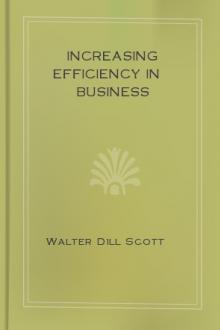Increasing Efficiency In Business, Walter Dill Scott [best novels for teenagers .TXT] 📗

- Author: Walter Dill Scott
- Performer: -
Book online «Increasing Efficiency In Business, Walter Dill Scott [best novels for teenagers .TXT] 📗». Author Walter Dill Scott
very interesting and helpful to all concerned.
Demonstrations should be more common.
COMPETITION
AS A MEANS OF INCREASING HUMAN
EFFICIENCY
THIRTY years ago American steel
makers were astonishing the world
with new production records. What
English ironmasters, intrenched in their
supremacy for centuries, had regarded as a
standard week’s output for Bessemer converters,
their young rivals in mills about the
Great Lakes were doubling, trebling, and even
further increasing. Hardly a month passed
without a new high mark and a shift in possession
of the leadership.
To this remarkable increase in efficiency
William R. Jones—“Captain Bill” Jones as
he was familiarly known—contributed more
than any other operating man. He was a
genius among executives as well as an inventor
<p 48>
<p 49>
of resource and initiative—a natural leader
and handler of men. When he was asked by
the British Iron and Steel Institute in 1881,
to explain the reasons for the amazing development
in the United States, he attributed it to
organization spirit of the workmen and the
rivalry among the various mills.
“So long as the record made by a mill
stands first,” he wrote, “its workmen are
content to labor at a moderate rate. But let
it be known that some other establishment
has beaten that record and there is no content
until the rival’s record is eclipsed.”
_It was on this idea of competition for
efficiency—of production as a game and achievement
as a goal—that the wonderful growth of
the steel industry was based_.
On the intensive development of this idea
by Andrew Carnegie, within his expanding
organization, hinged the tremendous progress
and profits of the Carnegie Company. “The
little boss” matched furnace against furnace,
mill against mill, superintendent against
superintendent. He scanned his weekly and
<p 50>
monthly reports not merely for records of
output, but for comparative consumption of
ore, fuel, and other supplies, for time and labor
costs in proportion to product.
If a superintendent, foreman, or gang failed
to respond to this urging, failed to get into
the race for the famous broom which crowned
the stack of the champion Carnegie mill or
furnace, the parallel showing of the other mills
became a club to drive the laggards into line.
So intense was the competition, so sharp the
verbal goads applied that Jones, after resigning
in indignation, parodied in sarcastic
notes in this manner the Carnegie fashion of
bringing executives to task: “Puppy dog
number three, you have been beaten by puppy
dog number two on fuel. Puppy dog number
two, you are higher on labor than puppy
dog number one.”
How effective was this system of pitting
man against man, plant against plant, was
shown by the dominant position of the Carnegie
Company in the trade when the Steel
Corporation was launched and by the stag-
<p 51>
gering value put upon its business. Indirect
testimony of the same fact was given another
time by Jones when he refused thousands of
dollars in yearly royalties for the use of his
inventions by outside companies, this though
the men who sought them were personal friends
and his contract with the Carnegie Company
allowed such licenses. His excuse was eloquent
of the power residing in the Carnegie
contest for efficiency and results: leadership
for his charge, the Edgar Thompson works, in
output and costs, meant more to him than
money and a chance to help his friends.
_The Carnegie system was one of the most
comprehensive applications in business of man’s
instinct of competition to the work of increasing
individual and organization efficiency_.
In the handling of executives it was carried
to such extremes as few great managers would
approve to-day. Undeniably, however, the
contest idea was an important influence in the
building up of a vast business in relatively brief
time, while the influence on the pace of the
whole industry gave the United States its
<p 52>
present supremacy in steel and iron. It survives
in the parallel comparisons of records
with which the Steel Corporation measures
the efficiency of its units of production and
keeps its mill superintendents to the mark.
It is utilized, in some degree and in varying
departments, by hundreds of successful houses.
Let us analyze the facts, the habits of
thought, the emotions behind competition and
determine where and how it may be applied
to the task of increasing our own and our
employees’ efficiency.
The experienced horseman knows that a
horse is unable to attain his greatest speed
apart from a pacemaker. The horse needs the
stimulus of an equal to get under way quickly,
to strike his fastest gait and to keep it up.
In this particular an athlete in sprinting is like
the horse. He is unable by sheer force of will
to run a hundred yards in ten seconds. To
achieve it he needs a competitor who will push
him to his utmost effort.
_The struggle for existence, one of the main
factors in the evolution of man, has raged most_
<p 53>
_fiercely among equals; without it, development
scarcely would have been possible_.
So fundamental has been this struggle
that the necessity for it has become firmly
established within us. We require it to stimulate
us to attain our highest ends.
As is made evident by a consideration of
imitation we are eminently social creatures.
We imitate the acts of those about us. Imitation
is, however, only the first stage of our
social relationship. We first imitate and then
compete. I purchase an automobile in imitation
of the acts of my friends, but I compete
with them by securing a more powerful or
swifter car. By erecting a new building because
some other banker has done so, the
second individual does more than imitate.
He competes with the first by planning to
erect a more magnificent structure and on a
more commanding site. Or a great retail
store, announcing a “February sale” of “white
goods” or furniture, invariably tries to surpass
the bargains offered by rival establishments.
<p 54>
We do indeed imitate and compete with all
our associates, but those whom we recognize
as our peers are the ones who stimulate
us more to the instinctive acts of imitation and
competition.
_Our actual equals stimulate us less than those
whom we recognize as the peers of our ideal
selves—of ourselves as we strive and intend to
become. The man on the ladder just above me
stirs me irresistibly_.
The effect of one individual upon others,
then, is not confined to imitation. There is
a constant tendency to vary from and to excel
the model. My devotion to golf is mainly due
to he example of some of my friends. My
ambition is to outplay these same friends.
Imitation and competition, apparently antagonistic,
are in reality the two expressions
for our social relationships. We first imitate
and then attempt to differentiate ourselves
from our companions.
The manufacturer or merchant imitates his
competitor, but tries also to surpass him.
Indeed it is a truism that competition is the
<p 55>
life of trade. In the shop and in the office,
on the road and behind the counter, in all
buying and selling, competition is essential
to the greatest success. Competition, the
desire to excel, is universal and instinctive.
It gives a zest to our work that would otherwise
be lacking. In every sphere of human
activity competition seems essential for securing
the best results.
_We assume ordinarily that competition exists
only between individuals. As a matter of fact,
a slight degree of competition may be aroused
between a man’s present efforts and his previous
records_.
While not so tense or so compelling as is
competition between individuals, it has the
advantage of avoiding the creation of jealousies.
In all the more exciting and stimulating
games, rivalry between individuals is a
prominent feature. In golf the game is frequently
played without this factor, the only
competition being with previous records or
with the mythical Bogy.
Such competition adds considerable zest
<p 56>
to the game, and the same principle is applicable
to business. The most compelling rivalry
is between peers; without this, however,
it is possible to pit the possibilities of the
present month against the achievements of
the previous four weeks or the past year or
even against a hypothetical individual “bogy.”
This bogy may be fixed by the executive, and
the man induced to compete with it. Thus
the dangers of competition may be minimized
and the advantages of the human instinctive
desire for competition be gained.
In the average well-organized business the
carrying out of such a plan would not be difficult.
Studying the previous records of his
men, a manager or foreman could determine
what each individual bogy should be. The
employee should know just what the _*record
is_ that he is competing with, and that his
success or failure would be recorded to his
credit or otherwise. Above all, the bogy
must be fair and within the power of the man
to accomplish.
Competition need not be confined to individuals.
<p 57>
_Frequently one city finds a stimulus in competing
with another. Nations compete with one another.
In any organization one section may compete
with another_.
In an army there may be competition between
regiments. Within the regiment there
may be the keenest rivalry between the different
companies. We are such social creatures
that we easily identify ourselves with our
block, our street, our town, our social set, our
party, our firm, or our department in the firm.
Like teams in any game or sport, these groups
may be rendered self-conscious and thus made
units for competition.
It is possible to create such units for
competition in business organizations. In some
instances individual employees of one firm
are pitted against those of a competing firm,
the contest proving stimulating to the men in
both. In other instances the competition is
restricted to the house, and similar departments
or sections are the units.
The closer the parallel between the units
and their activities, as in the Carnegie blast
<p 58>
furnaces and steel mills, the more interesting
and effective the competition becomes.
This principle has received widest recognition
and achieved greatest success in the
sales department. Here individuals are on
a footing of approximate equality or may be
given equality by a system of handicaps based
on conditions in their territories. Success
has also attended the pitting of selling districts
against each other. These larger competing
units work against bogies of the same
character as do the individual ones. The whole
house may be keyed up to surpass previous
records or to attain some fixed standard.
To ascertain to what extent the principle
of competition was consciously employed by
business firms and what methods were used
to apply it in increasing the efficiency of the
men, a number of successful business firms
were asked the following questions:—
_How do you utilize competition in increasing
efficiency among your employees?_
(1) Do you regard it as unwise to stimulate
competition in any form?
<p 59>
(2) Do you encourage men to excel their
own records of previous years?
(3) Do you encourage competition between
men in the same department?
(4) Do you encourage competition between
your own departments?
(5) Do you encourage competition with
departments of competing establishments?
(6) In competition do you make it fair
by “handicapping” your men?
What reward does the winner receive, e.g.:—
(1) Monetary reward?
(2) Promotion?
(3) Public commendation?
_In answers by equally successful managers
great diversity of opinion prevailed. Some
men were afraid of all forms of competition_.
They believed that co<o:>peration was essential
to success and that any form of competition
among the men tended to lessen such
co<o:>peration. Most of the men





Comments (0)